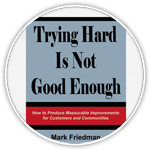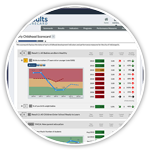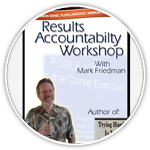Questions to Answer about Financing an Agenda to Improve Results for Children and Families
How to use this self assessment questionnaire: List each element of your action plan down the left side of a sheet. For each element that needs to be funded, ask all of the following questions. Make notes on the right side of the sheet about any financing approaches that look possible. Assign follow-up responsibility to gather more information or to take action on promising approaches.
A. REDEPLOYMENT: Using the resources already in the system.
1. Investment-based Redeployment: Where do the savings from our activities show up? Can we get our hands on those savings? (e.g. Family support centers increase the immunization rate and decrease Medicaid utilization; family preservation services decrease foster care entries and costs.) Approach those organizations that stand to benefit and ask for a share of their savings.
2. Capitation: Can we take the money in a package, instead of many individual streams and use money more flexibly across categorical boundaries to fund prevention services?
3. Cut-Based: Can we cut something that isn’t working so well to fund something that is? Can we shave small amounts from lots of places to generate resources for something new? (e.g. the state of Pennsylvania cut !% from a wide range of programs to fund the first 27 family support centers.)
4. Material: Can we use non-monetary resources (people, space equipment) to meet needs in our plan? (e.g. out-stationed workers, donated space etc.) Can we barter for things we need?
B. REVENUE: Finding new resources.
1. Open-ended Federal Funds: Can we tap into one of the remaining open-ended federal fund sources to pay for part of our plan?
a. Two ways to do this:
– Direct: Pay for the planned service directly with federal funds and non-federal match funds
– Indirect (sometimes called “refinancing”): Use open-ended federal funds to pay for something now paid with 100% state of local funds, freeing those funds for reinvestmentb. Two principle open-ended federal fund sources that can be used in this way. Each can pay for services and for broadly defined “administrative” activities. (Note that they can be politically and technically hard to access).
– Title IV-E: Foster Care and Subsidized Adoption
– Title XIX: Medicaid2. Capped Federal Funds: How can we get a share of capped categorical federal grant funds? These are usually fully spoken for, but the best places to look include:
a. Funds which are increasing: (rarer but still to be found) It’s always easier to get a share of new money than to fight for someone else’s current funding. Do your research on what’s going up. Head Start, Immunization, School to Work, Family Preservation and Support Act funds
b. Funds with (new) flexibility regarding use: Changes in federal education law make some funding sources (like Education’s Title I) more flexible. Welfare reform has made employment and child care funding more flexible; Waivers (like those used in the Oregon Option) have combined funding streams.
c. Funds which are competitive: Many federal grants are awarded competitively, either directly by the federal government or through the states (e.g. child abuse prevention grants, family support grants, community schools etc.) There are thousands of these grants awarded every year.
3. State and Local Funds:
a. Fair share of revenue growth: How can we assure that children get their “fair share” of growth in state and local funding (or are protected in a fair way from cuts)? Children’s Budgets (like those in Los Angeles, Oklahoma and Kansas) can help make the case.
b. Competitive grants: Are there state or local grant programs which can be used to fund the agenda? States often have their own programs such as state-only family support or child care programs.)
4. Private Funding: How can we use the following types of funding for parts of our plan:
a. Donations: Who are our current/potential partners? How can they help? Businesses, foundations, private citizens (One family support center has over 300 donors on its list).
b. Fees: Even small (sliding scale) charges can help.
c. Third party collections: Is someone else obligated to pay for this (e.g. health or other insurance)?
d. Loans: Can we use loans to help with program start-up funding or help our community agencies get needed credit (e.g. child care start-up) or help community economic development (such as the Newark New Community Corp.)
5. Politics and Grantsmanship: Who do we know? Who can we get to help? Money is politics. Use your connections. Hire someone full time or part time to go after grants. These positions almost always pay for themselves many times over.
C. RESTRUCTURING: Changing the structures and incentives which drive the use of money.
1. Fund pools: How can we package prevention and remediation dollars together to create an incentive to save on remediation and invest in prevention (the idea behind managed care and Iowa’s Decat program)?
2. Flexible dollars: Can we change the rules to allow workers to use small amounts of money flexibly to respond to family needs?
3. Incentives: can we change other incentives in the way institutions and people work together to improve outcomes for families and children?




Comments 1
Pingback: 2.14 How do I finance a results-based plan? | RBA Implementation Guide